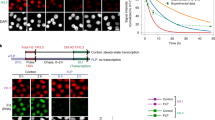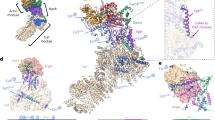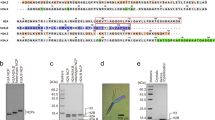Abstract
The mechanism by which newly synthesized histones are imported into the nucleus and deposited onto replicating chromatin alongside segregating nucleosomal counterparts is poorly understood, yet this program is expected to bear on the putative epigenetic nature of histone post-translational modifications. To define the events by which naive pre-deposition histones are imported into the nucleus, we biochemically purified and characterized the full gamut of histone H3.1–containing complexes from human cytoplasmic fractions and identified their associated histone post-translational modifications. Through reconstitution assays, biophysical analyses and live cell manipulations, we describe in detail this series of events, namely the assembly of H3–H4 dimers, the acetylation of histones by the HAT1 holoenzyme and the transfer of histones between chaperones that culminates with their karyopherin-mediated nuclear import. We further demonstrate the high degree of conservation for this pathway between higher and lower eukaryotes.
This is a preview of subscription content, access via your institution
Access options
Subscribe to this journal
Receive 12 print issues and online access
$189.00 per year
only $15.75 per issue
Buy this article
- Purchase on Springer Link
- Instant access to full article PDF
Prices may be subject to local taxes which are calculated during checkout







Similar content being viewed by others
References
Eickbush, T.H. & Moudrianakis, E.N. The histone core complex: an octamer assembled by two sets of protein-protein interactions. Biochemistry 17, 4955–4964 (1978).
Luger, K., Mader, A.W., Richmond, R.K., Sargent, D.F. & Richmond, T.J. Crystal structure of the nucleosome core particle at 2.8 A resolution. Nature 389, 251–260 (1997).
Campos, E.I. & Reinberg, D. Histones: annotating chromatin. Annu. Rev. Genet. 43, 559–599 (2009).
Hake, S.B. & Allis, C.D. Histone H3 variants and their potential role in indexing mammalian genomes: the “H3 barcode hypothesis”. Proc. Natl. Acad. Sci. USA 103, 6428–6435 (2006).
Koessler, H., Doenecke, D. & Albig, W. Aberrant expression pattern of replication-dependent histone h3 subtype genes in human tumor cell lines. DNA Cell Biol. 22, 233–241 (2003).
Sogo, J.M., Stahl, H., Koller, T. & Knippers, R. Structure of replicating simian virus 40 minichromosomes. The replication fork, core histone segregation and terminal structures. J. Mol. Biol. 189, 189–204 (1986).
Annunziato, A.T. Split decision: what happens to nucleosomes during DNA replication? J. Biol. Chem. 280, 12065–12068 (2005).
Xu, M. et al. Partitioning of histone H3–H4 tetramers during DNA replication-dependent chromatin assembly. Science 328, 94–98 (2010).
Gruss, C., Wu, J., Koller, T. & Sogo, J.M. Disruption of the nucleosomes at the replication fork. EMBO J. 12, 4533–4545 (1993).
Tagami, H., Ray-Gallet, D., Almouzni, G. & Nakatani, Y. Histone H3.1 and H3.3 complexes mediate nucleosome assembly pathways dependent or independent of DNA synthesis. Cell 116, 51–61 (2004).
Benson, L.J. et al. Modifications of H3 and H4 during chromatin replication, nucleosome assembly, and histone exchange. J. Biol. Chem. 281, 9287–9296 (2006).
English, C.M., Maluf, N.K., Tripet, B., Churchill, M.E. & Tyler, J.K. ASF1 binds to a heterodimer of histones H3 and H4: a two-step mechanism for the assembly of the H3–H4 heterotetramer on DNA. Biochemistry 44, 13673–13682 (2005).
English, C.M., Adkins, M.W., Carson, J.J., Churchill, M.E. & Tyler, J.K. Structural basis for the histone chaperone activity of Asf1. Cell 127, 495–508 (2006).
Natsume, R. et al. Structure and function of the histone chaperone CIA/ASF1 complexed with histones H3 and H4. Nature 446, 338–341 (2007).
Groth, A. et al. Regulation of replication fork progression through histone supply and demand. Science 318, 1928–1931 (2007).
Jasencakova, Z. et al. Replication stress interferes with histone recycling and predeposition marking of new histones. Mol. Cell 37, 736–743 (2010).
Verreault, A., Kaufman, P.D., Kobayashi, R. & Stillman, B. Nucleosomal DNA regulates the core-histone-binding subunit of the human Hat1 acetyltransferase. Curr. Biol. 8, 96–108 (1998).
Loyola, A., Bonaldi, T., Roche, D., Imhof, A. & Almouzni, G. PTMs on H3 variants before chromatin assembly potentiate their final epigenetic state. Mol. Cell 24, 309–316 (2006).
Smith, S. & Stillman, B. Purification and characterization of CAF-I, a human cell factor required for chromatin assembly during DNA replication in vitro. Cell 58, 15–25 (1989).
Tyler, J.K. et al. Interaction between the Drosophila CAF-1 and ASF1 chromatin assembly factors. Mol. Cell. Biol. 21, 6574–6584 (2001).
Mello, J.A. et al. Human Asf1 and CAF-1 interact and synergize in a repair-coupled nucleosome assembly pathway. EMBO Rep. 3, 329–334 (2002).
Crampton, C.F., Moore, S. & Stein, W.H. Chromatographic fractionation of calf thymus histone. J. Biol. Chem. 215, 787–801 (1955).
Han, C. et al. HDJC9, a novel human type C DnaJ/HSP40 member interacts with and cochaperones HSP70 through the J domain. Biochem. Biophys. Res. Commun. 353, 280–285 (2007).
Richardson, R.T. et al. Characterization of the histone H1-binding protein, NASP, as a cell cycle-regulated somatic protein. J. Biol. Chem. 275, 30378–30386 (2000).
Alekseev, O.M., Widgren, E.E., Richardson, R.T. & O'Rand, M.G. Association of NASP with HSP90 in mouse spermatogenic cells: stimulation of ATPase activity and transport of linker histones into nuclei. J. Biol. Chem. 280, 2904–2911 (2005).
Song, J.J., Garlick, J.D. & Kingston, R.E. Structural basis of histone H4 recognition by p55. Genes Dev. 22, 1313–1318 (2008).
Murzina, N.V. et al. Structural basis for the recognition of histone H4 by the histone-chaperone RbAp46. Structure 16, 1077–1085 (2008).
Han, J., Zhou, H., Li, Z., Xu, R.M. & Zhang, Z. Acetylation of lysine 56 of histone H3 catalyzed by RTT109 and regulated by ASF1 is required for replisome integrity. J. Biol. Chem. 282, 28587–28596 (2007).
Finn, R.M., Browne, K., Hodgson, K.C. & Ausio, J. sNASP, a histone H1-specific eukaryotic chaperone dimer that facilitates chromatin assembly. Biophys. J. 95, 1314–1325 (2008).
Andrews, A.J., Downing, G., Brown, K., Park, Y.J. & Luger, K. A thermodynamic model for Nap1-histone interactions. J. Biol. Chem. 283, 32412–32418 (2008).
Vistica, J. et al. Sedimentation equilibrium analysis of protein interactions with global implicit mass conservation constraints and systematic noise decomposition. Anal. Biochem. 326, 234–256 (2004).
Dunleavy, E.M. et al. A NASP (N1/N2)-related protein, Sim3, binds CENP-A and is required for its deposition at fission yeast centromeres. Mol. Cell 28, 1029–1044 (2007).
Poveda, A. et al. Hif1 is a component of yeast histone acetyltransferase B, a complex mainly localized in the nucleus. J. Biol. Chem. 279, 16033–16043 (2004).
Fillingham, J. et al. Chaperone control of the activity and specificity of the histone H3 acetyltransferase Rtt109. Mol. Cell. Biol. 28, 4342–4353 (2008).
Sundin, B.A., Chiu, C.H., Riffle, M., Davis, T.N. & Muller, E.G. Localization of proteins that are coordinately expressed with Cln2 during the cell cycle. Yeast 21, 793–800 (2004).
Mousson, F. et al. Structural basis for the interaction of Asf1 with histone H3 and its functional implications. Proc. Natl. Acad. Sci. USA 102, 5975–5980 (2005).
Hartl, F.U. & Hayer-Hartl, M. Converging concepts of protein folding in vitro and in vivo. Nat. Struct. Mol. Biol. 16, 574–581 (2009).
Wang, H., Walsh, S.T. & Parthun, M.R. Expanded binding specificity of the human histone chaperone NASP. Nucleic Acids Res. 36, 5763–5772 (2008).
Welch, J.E., Zimmerman, L.J., Joseph, D.R. & O'Rand, M.G. Characterization of a sperm-specific nuclear autoantigenic protein. I. Complete sequence and homology with the Xenopus protein, N1/N2. Biol. Reprod. 43, 559–568 (1990).
Richardson, R.T. et al. Nuclear autoantigenic sperm protein (NASP), a linker histone chaperone that is required for cell proliferation. J. Biol. Chem. 281, 21526–21534 (2006).
Nishioka, K. & Reinberg, D. Methods and tips for the purification of human histone methyltransferases. Methods 31, 49–58 (2003).
Dignam, J.D., Martin, P.L., Shastry, B.S. & Roeder, R.G. Eukaryotic gene transcription with purified components. Methods Enzymol. 101, 582–598 (1983).
Shevchenko, A., Wilm, M., Vorm, O. & Mann, M. Mass spectrometric sequencing of proteins silver-stained polyacrylamide gels. Anal. Chem. 68, 850–858 (1996).
Pungaliya, P. et al. TOPORS functions as a SUMO-1 E3 ligase for chromatin-modifying proteins. J. Proteome Res. 6, 3918–3923 (2007).
Craig, R., Cortens, J.P. & Beavis, R.C. Open source system for analyzing, validating, and storing protein identification data. J. Proteome Res. 3, 1234–1242 (2004).
Peters, A.H. et al. Partitioning and plasticity of repressive histone methylation states in mammalian chromatin. Mol. Cell 12, 1577–1589 (2003).
Trojer, P. et al. Dynamic histone H1 isotype 4 methylation and demethylation by histone lysine methyltransferase G9a/KMT1C and the Jumonji domain-containing JMJD2/KDM4 proteins. J. Biol. Chem. 284, 8395–8405 (2009).
Acknowledgements
Funding for this project was provided by the Howard Hughes Medical Institute, by US National Institutes of Health grants GM064844 and R37GM037120 (D.R.), by the Natural Sciences and Engineering Research Council of Canada (E.I.C. and W.-H.W.K.), the Canadian Cancer Society Research Institute (J.F.G.) and by the Deutsche Akademie der Naturforscher Leopoldina (Leopoldina Fellowship Program, LPDS 2009-5, P.V.). The eH3.1 HeLa S3 cells were kindly provided by H. Tagami and G. Almouzni (Institut Curie). The HAT1–RbAp46, WT ASF1B and V94R Asf1 constructs were kind gifts from B. Stillman (Cold Spring Harbor Laboratory), H. Silljé (Max Planck Institute) and C. Mann (CEA Saclay), respectively. The baculoviruses expressing human HAT1 and RbAp46 were kindly provided by R. Kingston (Harvard Medical School). We also thank S. Mehta and S. Kim for technical support with tissue culture, G. Zhong for help with yeast TAP purification and J. Zhang for a copious amount of histones. We are grateful to L. Vales for comments on the manuscript.
Author information
Authors and Affiliations
Contributions
E.I.C. performed the tissue culture–related work and biochemical purification of eH3.1, sNASP and ASF1B; protein interaction and enzymatic assays, with assistance from Z.G.; subcloning and mutagenesis; cross-linking experiments, with the assistance of P.V.; AUC runs, with the assistance of L.A.D.; and RNAi experiments. J.F. performed the work in S. cerevisiae with assistance from W.-H.W.K. and H.S. G.L. cloned sNASP and generated stable sNASP clones. H.Z. performed the mass spectrometry analyses. Experiments were performed under the supervision of D.R. and J.F.G. The manuscript was written by E.I.C. and D.R. with assistance from the other authors.
Corresponding author
Ethics declarations
Competing interests
The authors declare no competing financial interests.
Supplementary information
Supplementary Text and Figures
Supplementary Figures 1–6 and Supplementary Tables 1–3 (PDF 3656 kb)
Rights and permissions
About this article
Cite this article
Campos, E., Fillingham, J., Li, G. et al. The program for processing newly synthesized histones H3.1 and H4. Nat Struct Mol Biol 17, 1343–1351 (2010). https://doi.org/10.1038/nsmb.1911
Received:
Accepted:
Published:
Issue Date:
DOI: https://doi.org/10.1038/nsmb.1911
This article is cited by
-
Probing cell membrane integrity using a histone-targeting protein nanocage displaying precisely positioned fluorophores
Nano Research (2023)
-
Histone chaperone ASF1 mediates H3.3-H4 deposition in Arabidopsis
Nature Communications (2022)
-
The histone chaperone Nrp1 is required for chromatin stability and nuclear division in Tetrahymena thermophila
Epigenetics & Chromatin (2021)
-
The construction and validation of an RNA binding protein-related prognostic model for bladder cancer
BMC Cancer (2021)
-
JMJD1B, a novel player in histone H3 and H4 processing to ensure genome stability
Epigenetics & Chromatin (2020)



